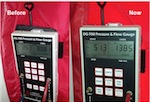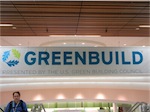The latest work done on Cathy’s house is the application of insulation. They have decided to use blown cellulose to fill the exterior walls and the cathedral ceiling. The cellulose insulation is expected to yield R-13 for the walls and R-38 for the ceiling. The
‘ target=’_blank’>Cellulose is a sustainable product made from recycled newspapers and is a great insulating material.
In this process, the contractor first sheetrocked the walls and the ceiling. The insulation contractor then drilled two to four holes for each wall/ceiling panel. Multiple holes were needed for each panel to ensure a dense pack and that no wiring or frame inside the wall/ceiling will block the flow of the cellulose. A blowing machine located from their truck parked outside the house was used to blow the cellulose through a long hose into the hole. The holes were then plugged and the sheetrocks patched for painting.
An energy analyst calculated the energy usage of Cathy’s house before and after the remodel. The energy improvement measures include air sealing, floor insulation, wall insulation, attic insulation, new windows, and a new heating and air conditioning system. The result was remarkable. Since the house is located in a mild climate, it does not require much air conditioning in summer. The energy saving comes from the reduction is gas heating. The modeling tool shows that a total energy reduction (gas and electric both converted to equivalent btu hours) of a whopping 53%. It is expected that this project will receive the full Energy Upgrade California rebate as well as the full rebate from the County. Great going!
This forum provides you with resources about home renovation, improvement, makeover and repair topics such as bathroom design, cabinet replacement, countertop selection, drainage, drought tolerant plants, flooring, furnace, furniture, gardening, home appliances, home design, hot water heater, landscape planning, landscape replacement, low flow toilets, moisture management, non-toxic material, paint selection, plumbing, remodel planning, retrofit, roof replacement, saving water, solar hot water, window replacement, and many others. While we focus on issues in California, particularly in the San Francisco Bay Area, San Jose, Oakland, Campbell, Cupertino, Marin, Menlo Park, Mill Valley, Palo Alto, Pleasanton, Redwood City, San Mateo, San Ramon, Santa Rosa, Sunnyvale, most information is applicable in all parts of USA as well as the rest of the world.









53% is a significant reduction of energy use! I wonder if I can reduce that much energy use if I just do the energy retrofit and not the remodel.
I am sorry you are having these prolbems, but the problem is with the installer, not the insulation. If a new roof leaks and ultimately damages the ceiling under it is it the fault of the shingles or the person who installed them? All loose-fill insulation, cellulose or fiber glass, contains some dust. A dusty environment can result in allergic reactions and sometimes congestion. It is normal practice when walls or attics are retrofitted with any loose fill insulation to inspect ducts in the insulated area and membrane penetrations, and to seal as necessary to prevent dust and fibers from entering the living area of the home. In any case there is nothing that is considered hazardous in cellulose insulation. It typically consists of approximately 85% recovered paper fiber ande 15% fire retardants. The common fire retardants are boric acid, which is also used as an eye wash and is a primary component of virtually all OTC and prescrsiption eye medications as well as contact lens solutions; sodium borate, also known as borax and used to wash clothes; and sometimes ammonium sulfate, also used as food preservative and fertilizer. None of these components are regarded as hazardous by any authority. Cellulose insulation is classified as a nuisance dust, that is dust that may be irritating in large concentrations, but causes no permanent harm. The respirable fraction of cellulose insulation is less than 0.1%. Animal inhalation studies by the National Toxicology Program revealed only minor irritation from exposure to cellulose insulation, and an occupational exposure study of cellulose insulation by the National Institute of Occupational Safety and Health found no health prolbems among workers who install cellulose insulation every day.
I don’t know who you wrote this for but you helped a broethr out.
Assuming an open blow on an attic floor comments about the need to add more csolullee insulation to compensate for settling are incorrect. Cellulose insulation coverage charts are based on settled density. They have been for more than 30 years. Compensation for settlement is built right into the coverage chart. You do NOT have to add more insulation than is specified by the chart to obtain the desired R-value. Immediately after installation the home owner benefits from bonus R-value.While it might be possible to spray some wall spray products against the underside of a sloped roof and have the insulation remain in place for a while, this material is not intended to remain exposed and unsupported in walls or roofs. The usual method for insulating a cathedralized roof-ceiling assembly is to blow the insulation behind webbing ot netting.
Great post you have added, and the strategy you are using it’s nice. The images you have added here of the whole work it is really great. Insulation is really a best option for making our homes more comfortable and keep protect to weather changes. I want to say thanks for sharing this great post.
insulation blowers